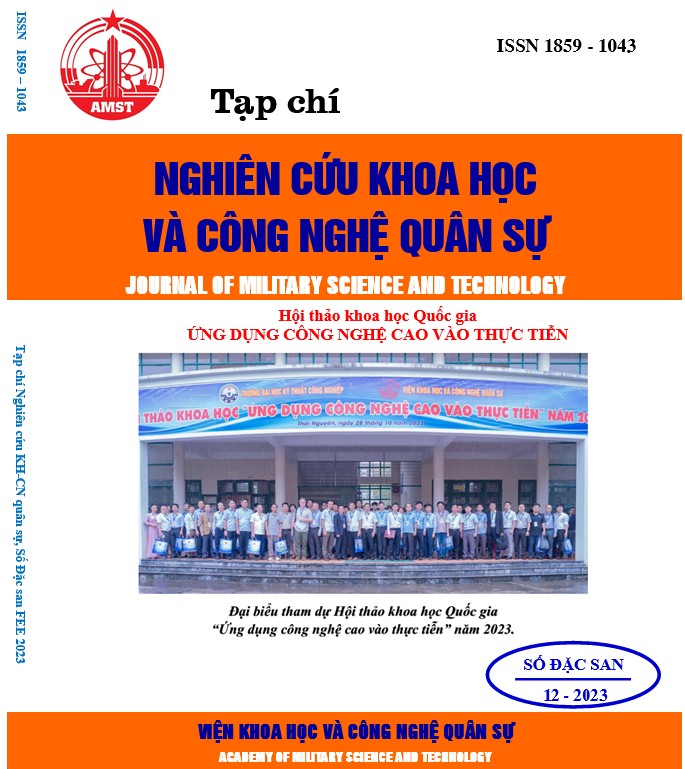Research and calculate the theory of laser pulse energy for water observation equipment
818 viewsDOI:
https://doi.org/10.54939/1859-1043.j.mst.FEE.2023.111-118Keywords:
Underwater vision devices; Pulsed lasers; Range-gated underwater laser imaging.Abstract
In this paper, the results of the theoretical calculation of laser pulse illumination energy of underwater observation equipment were presented. Using a simulation of environmental conditions, observed objects, parameters of laser pulse width, repetition frequency and optical objective system to obtain images, thereby determining the laser pulse energy depending on the distance. Specifically, the results had shown that to achieve human target detection distance of up to 30 m and identification to 27 m, it is necessary to use a laser with a pulse energy of at least 5 mJ (with a pulse width of 3 ns and frequency of 1kHz). This result ensures the selection of suitable laser pulse illumination energy for underwater observation equipment according to the requirement of target observation distance.
References
[1]. Y. Shen et al, “Underwater Optical Imaging: Key Technologies and Applications Review,” IEEE Access, Vol. 9, pp. 85500-85514, (2021). DOI: https://doi.org/10.1109/ACCESS.2021.3086820
[2]. F. Christnacher et al, “3D laser gated viewing from a moving submarine platform,” Proc. SPIE, Vol. 9250, p. 920500, (2014). DOI: https://doi.org/10.1117/12.2066817
[3]. P. Mariani et al, “Range-gated imaging system for underwater monitoring in ocean environment,” Sustainability, Vol. 11, p. 162, (2018). DOI: https://doi.org/10.3390/su11010162
[4]. X. Liu et al, “Automatic fishing net detection and recognition based on optical gated viewing for underwater obstacle avoidance,” Opt. Eng., Vol. 56, p. 083101, (2017). DOI: https://doi.org/10.1117/1.OE.56.8.083101
[5]. J. E. Tyler et al, “The Secchi disc,” Limnology and Oceanography, Vol. 13, pp. 1-6, (1968). DOI: https://doi.org/10.4319/lo.1968.13.1.0001
[6]. T. Berman et al, “A. Secchi disk depth record: A claim for the eastern Mediterranean,” Limnology and Oceanography, Vol. 30(2), pp. 447-448, (1985). DOI: https://doi.org/10.4319/lo.1985.30.2.0447
[7]. https://photonicscience.com/products/iccd-cameras/intensified-ccd-cmos-camera/.
[8]. https://www.photonis.com/products/inocturn.
[9]. Грузевич Ю. К. Оптико-электронные приборы ночного видения. - М.: ФИЗМАТЛИТ. - 276 с. - ISBN 978-5-9221-1550-6. 40, (2014).
[10]. L. B. Scott et al, “Modeling staring thermal systems with FLIR92,” Proc. SPIE, Vol. 1993, pp. 21–26, (1969). DOI: https://doi.org/10.1117/12.154721
[11]. “Teopия оптико-электроных систем”: Учебник для студентов вузов no оптческим сnециальностям./Г. М. Мосягин, В. Б. Немтиенов, Е. Н. Лебедев. -М.: Машиностроение, pp. 13-24, (1990).
[12]. Карасик В. Е. “Лазерные системы видения : учебное пособие для вузов” / В. Е. Карасик, В. М. Орлов. - Москва: Изд-во МГТУ им. Н. Э. Баумана, (2001).
[13]. Иванов А.П. “Обнаружение глубинных зон повышенной прозрачности морской воды методом импульсного лазерного зондирования”, Оптика атмосферы и океана, 9, N 12 (1996).
[14]. Arnold Daniels et al, “Field guide to infrared systems, detectors, and FPAs”/Third edition. Bellingham, Washington, USA : SPIE Press, pp. 109-111, (2018). DOI: https://doi.org/10.1117/3.2315935
[15]. N. S. Kopeika et al, “A System Engineering Approach to Imaging,” SPIE Optical Engineering Press, pp. 341-347, (1998). DOI: https://doi.org/10.1117/3.2265069







